
Uncover the 10 Sustainable Secrets of the Air Fryer
As a busy home cook, I love finding ways to make life easier and greener. I know the struggle of trying to be sustainable while also getting dinner on the table quickly. I have spent years learning how small changes to our appliances can make a big impact on the environment. Join me as we explore the surprising ways the simple air fryer can be a powerful tool in your own green kitchen revolution and reveal its 10 Sustainable Secrets.
Introduction
The air fryer is a popular kitchen machine. It has become a must-have for many home cooks. And can turn frozen foods into crispy, golden snacks. It also makes weeknight meals fast and simple. Many people first bought an air fryer because of the health benefits. It lets you ‘fry’ food with very little oil. However, its true value goes far beyond healthier eating. The modern air fryer is actually a champion of sustainability. It uses smart design and technology. This fits perfectly with an eco-conscious way of life.
Living sustainably means we must look at how much energy we use. We must check how products are made. We must also think about how long they last. Kitchen appliances often use a lot of power. They can drain a lot of energy. By looking at ten main features, we can see the air fryer’s true potential. It is a real green hero. These ten points are not just small add-ons. They are built-in ‘secrets’ that work together. That lower your energy use. And cut down on waste. They help create a healthier planet.
Let’s look closely at how this machine is built and how it works. We will Uncover the 10 Sustainable Secrets of the Air Fryer.
1. Energy Efficiency Through Concentrated Heat

The top sustainability secret of the air fryer is how it works. It heats a small space quickly and well. This makes it super-efficient. A normal large oven needs a lot of energy to heat up. It must keep the heat high across its big inside area. The air fryer works differently. It uses a strong heat source and a fan in a tiny space. This cuts energy waste a great deal.
Example:
Think about making roasted vegetables or chicken wings. A regular oven might need 10 to 15 minutes to preheat to 400°F (200°C). Then it needs 30 minutes to cook the food. The air fryer needs less than a minute to preheat. It also cuts the total cooking time a lot. Sometimes it uses less than half the time of a full oven. This high efficiency means you use fewer kilowatt-hours (kWh). This lowers your power bills. It also shrinks your carbon footprint.
How to Do It:
Try to use the air fryer for every food item that will fit. Do not just preheat your big oven out of habit. Even for foods you usually bake, try an air fryer recipe. This includes small pies or cookies. This small change in your routine makes the most of the machine’s heat power. It saves a lot of energy over time.
2. Multi-Functionality: The Appliance Reducer

A kitchen full of single-use tools is costly for the planet. Think of a deep fryer, a toaster oven, a dehydrator, and an indoor grill. Each of these takes materials and energy to make. They also become electronic trash later. Many new air fryers are made to do many jobs at once. This ‘secret’ of multi-tasking cleans up your kitchen. It also cuts down on e-waste.
Example:
The best air fryer models often have different settings. They may include ‘Bake,’ ‘Roast,’ ‘Dehydrate,’ and ‘Proof.’ By joining these tasks, one air fryer can replace three or four less-efficient machines. This simple reduction in the number of products made is a strong step. It helps save natural resources.
How to Do It:
When you buy or replace a kitchen tool, choose a model that does many things well. Look for air fryers that talk about being versatile. Dehydration is a key function to look for. It lets you save food easily. This helps reduce food waste. Make a long-term, smart investment in one machine that does it all.
3. Durable and Repairable Construction
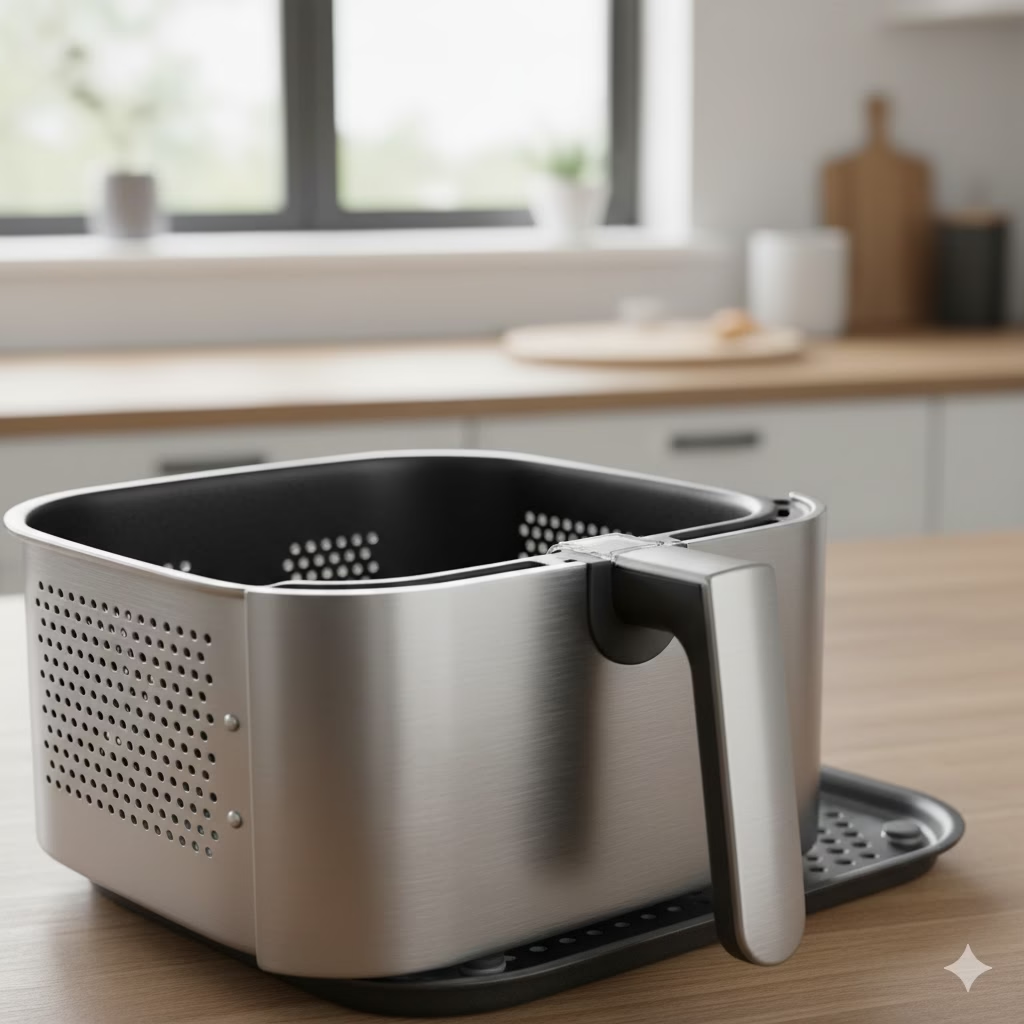
The idea of ‘Buy It for Life’ is key to sustainability. Air fryers that are strong and easy to fix are a secret weapon. They fight against the growing problem of electronic waste. Machines that break after two years because of a small, unfixable part cause a huge trash problem. They fill up landfills fast.
Example:
Top air fryer makers often use tough, good-quality parts. They design them so they can be fixed with simple replacement parts. And they might give long warranties (three to five years). They also keep spare parts in stock. These parts include baskets, heating elements, or circuit boards. This allows customers to fix the machine instead of throwing it away.
How to Do It:
Before buying, check the warranty length. See if the company offers spare parts. Read what other buyers say about how long the appliance lasts. Once you own one, register your product. Follow the cleaning and care guide exactly. This will make sure your air fryer lasts for its longest possible life.
4. Non-Toxic and Responsible Coatings

Many older cooking tools use regular non-stick coatings. These often contain chemicals called PFAS. This includes PFOA and PTFE. These chemicals are harmful to the environment during manufacturing and when thrown away. The fourth sustainable secret is that companies are now using safer, better choices.
Example:
More and more manufacturers are using ceramic non-stick coatings. These are usually free of PFOA and PTFE. Some brands even use food-grade stainless steel for the cooking basket. Steel is a very strong and safe material. It completely removes worries about chemical coatings.
How to Do It:
Always read the details about the cooking surface. Look for labels that say “PFOA-free”, “PTFE-free”, or “Ceramic Non-Stick”. If you choose stainless steel, you will need to clean it a bit more carefully. However, the long-term benefit for the environment is great. It is a good trade-off.
5. Smart Programming for Optimized Use
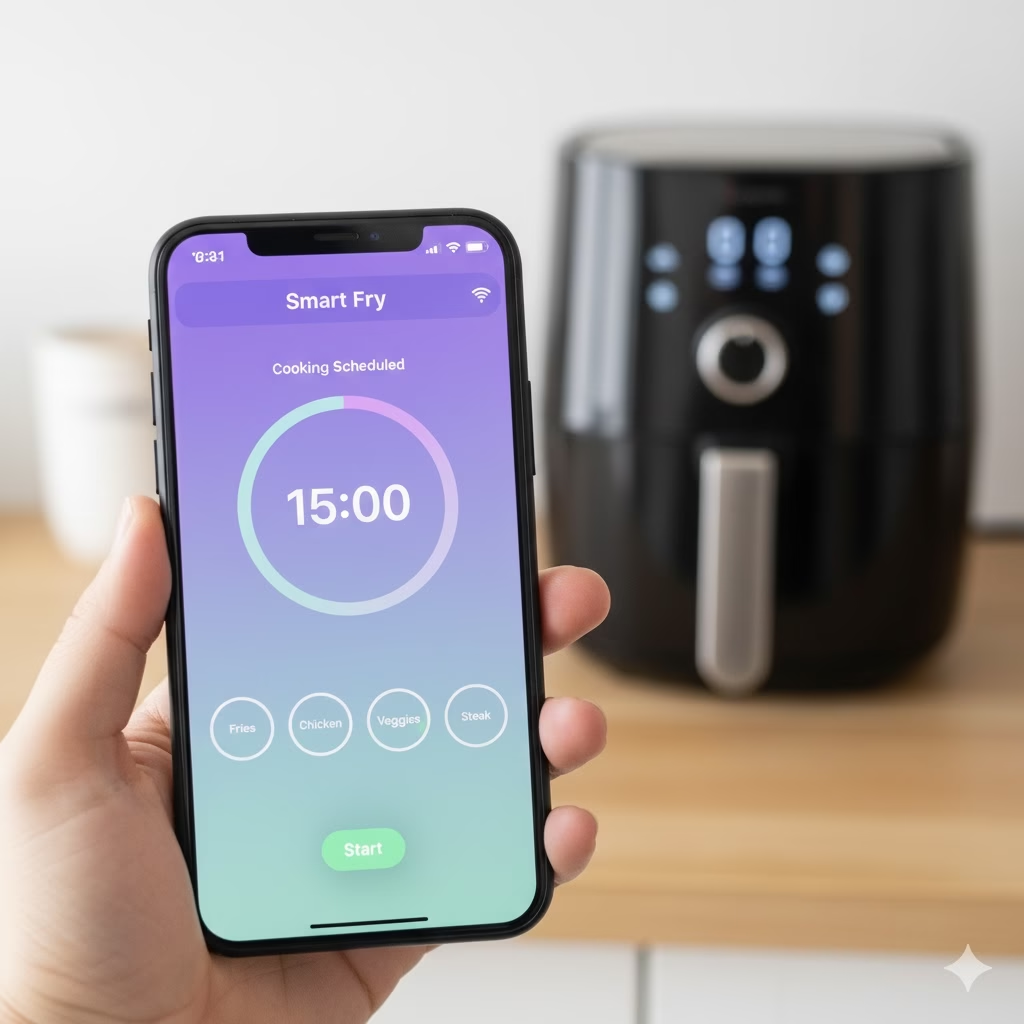
Using smart technology may seem like just a nice extra feature. But it holds a quiet sustainability secret. Air fryers with Wi-Fi let you control and schedule cooking very precisely. This uses energy in the best way. It also cuts down on food waste caused by cooking mistakes.
Example:
You can use a special app to control your smart air fryer. You can program the exact time and temperature from a recipe. This stops the need for trial-and-error cooking. Trial-and-error often means running the machine too long or ruining the food. Ruined food is wasted food. The app can also tell you when the cooking is finished. This stops the air fryer from staying on in standby mode for no reason.
How to Do It:
Connect your smart air fryer to the company’s app. Use the ready-made settings. These settings are often set at the factory to be very efficient for common foods. Try using the delayed start feature. This lets you match the cooking time with when you plan to eat. This ensures the machine does not sit idle and hot for long times.
6. Minimal Standby Power (The Vampire Draw Solution)
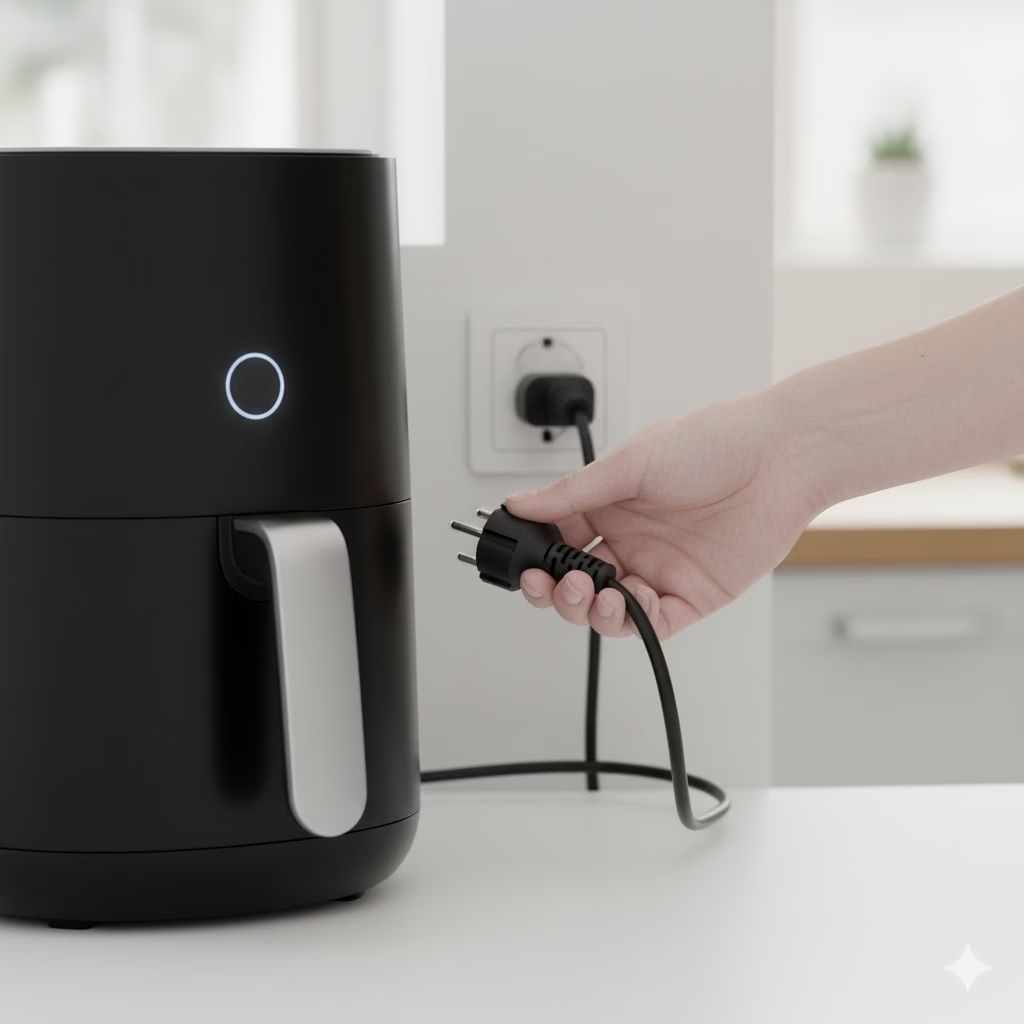
Almost every appliance that is plugged in and shows a light or a clock is using a small amount of power. This is called ‘vampire power’ or standby power. One device uses very little. But all of these devices together waste a lot of electricity worldwide. The sustainable secret here is a design that uses very little or no standby power.
Example:
Eco-friendly air fryer designs use almost zero power when they are off. They often look completely ‘dead’ when not in use. Some models have a physical power button that truly cuts the electricity flow. This means you do not have to unplug the machine from the wall.
How to Do It:
The easiest way to use this feature is to unplug the air fryer when you are done cooking. For easier use, you can plug the appliance into a power strip. Then you can just flip the switch on the strip to turn off the power. A smart plug is also a good choice. It can track and cut the power use when the machine is not cooking.
7. Reduced Use of Cooking Oils and Fat

The air fryer does not need to use zero oil. But its main purpose is to cut down hugely on the need for deep-frying. This oil reduction is a strong sustainability secret. Its effect goes far beyond just your health. Less oil used means less energy spent on making, packaging, and shipping cooking oils.
Example:
A traditional deep fryer needs litres of oil. This oil must be heated, cleaned, and finally thrown away. The oil disposal is often done wrongly. This can harm city water systems. An air fryer only needs a quick spray or a small tablespoon of oil. This gives you great results while cutting down greatly on waste oil.
How to Do It:
When you get your food ready, use a spray bottle to put a light mist of oil on it. Do not pour the oil. After cooking, before cleaning the basket, use a paper towel to wipe up any extra oil or fat. This simple step stops the fat from going down your sink. This helps protect local water systems.
8. Recyclable and Minimalist Packaging
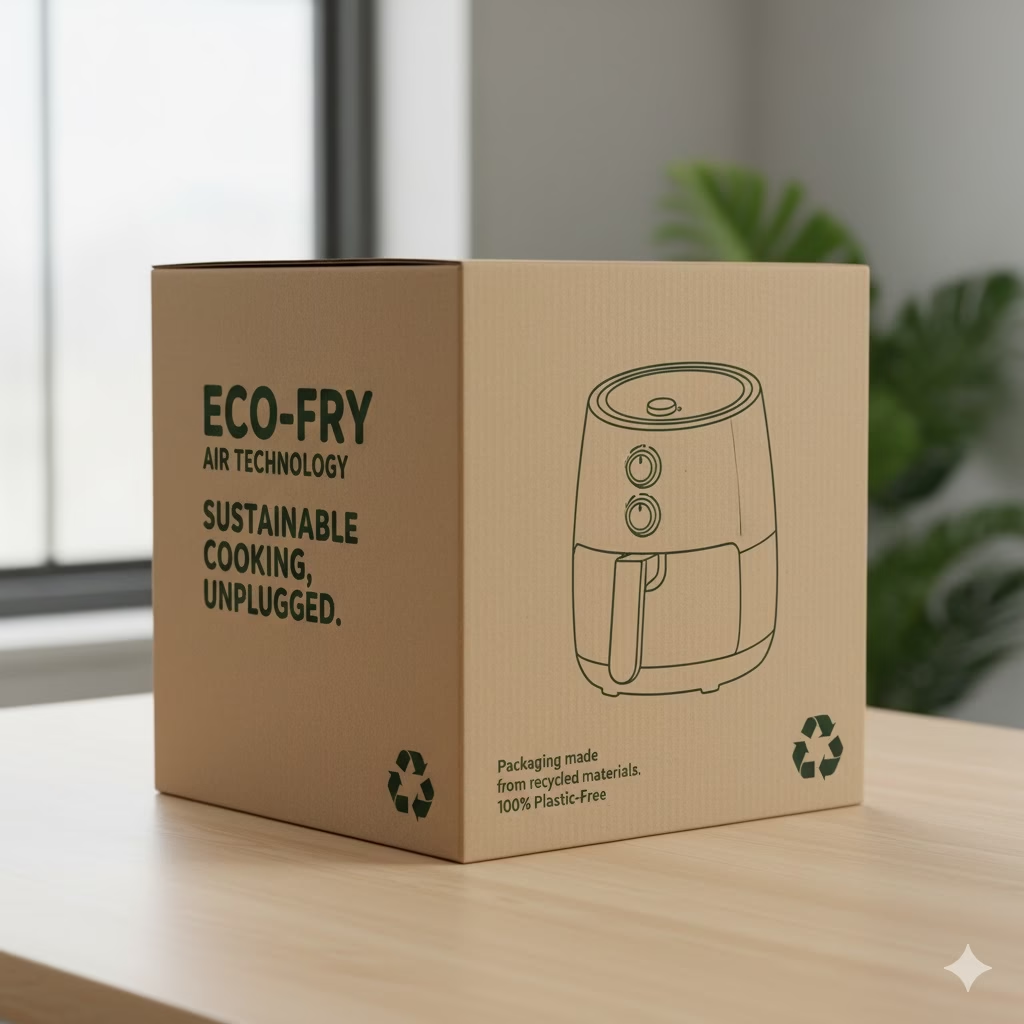
The air fryer’s journey to being sustainable starts with its box. Green-minded companies use the secret of simple, recyclable packaging. This cuts down on waste before the machine even gets to your kitchen. It is an important first step.
Example:
Sustainable brands avoid using too much Styrofoam. Styrofoam is a plastic foam that is hard to recycle. Instead, they use shaped cardboard. They use paper pulp inserts. And use very little plastic wrap. They often use plant-based inks on the boxes. They make the boxes smaller to save fuel during shipping.
How to Do It:
When you unpack your air fryer, sort the trash right away. Put all the recyclable materials like cardboard and paper manuals together. Separate any soft plastic wrap. Send a quick message to the company. Tell them thank you for the eco-friendly packaging. Or tell them how they can improve. Customer feedback helps guide companies to be better.
9. Easy-Clean, Dishwasher-Safe Components

The ninth secret helps save water and cleaning chemicals. If a machine part is hard to clean, people use too much water to soak it. They often use strong, chemical-filled cleaning products. Air fryers with parts that are easy to clean help stop this waste.
Example:
A basket and crisper plate that are non-stick and safe for the dishwasher are best. They help you clean using less water. The smooth shape of the parts stops food from getting stuck in corners. Stuck food leads to a lot of water being wasted during manual cleaning.
How to Do It:
Clean the parts as soon as you are done cooking. Clean them while they are still a little warm (but not hot!). This stops food from baking onto the surface. Put all the safe parts in the dishwasher. If you wash by hand, choose an eco-friendly, natural dish soap.
10. Sustainable Sourcing of Materials
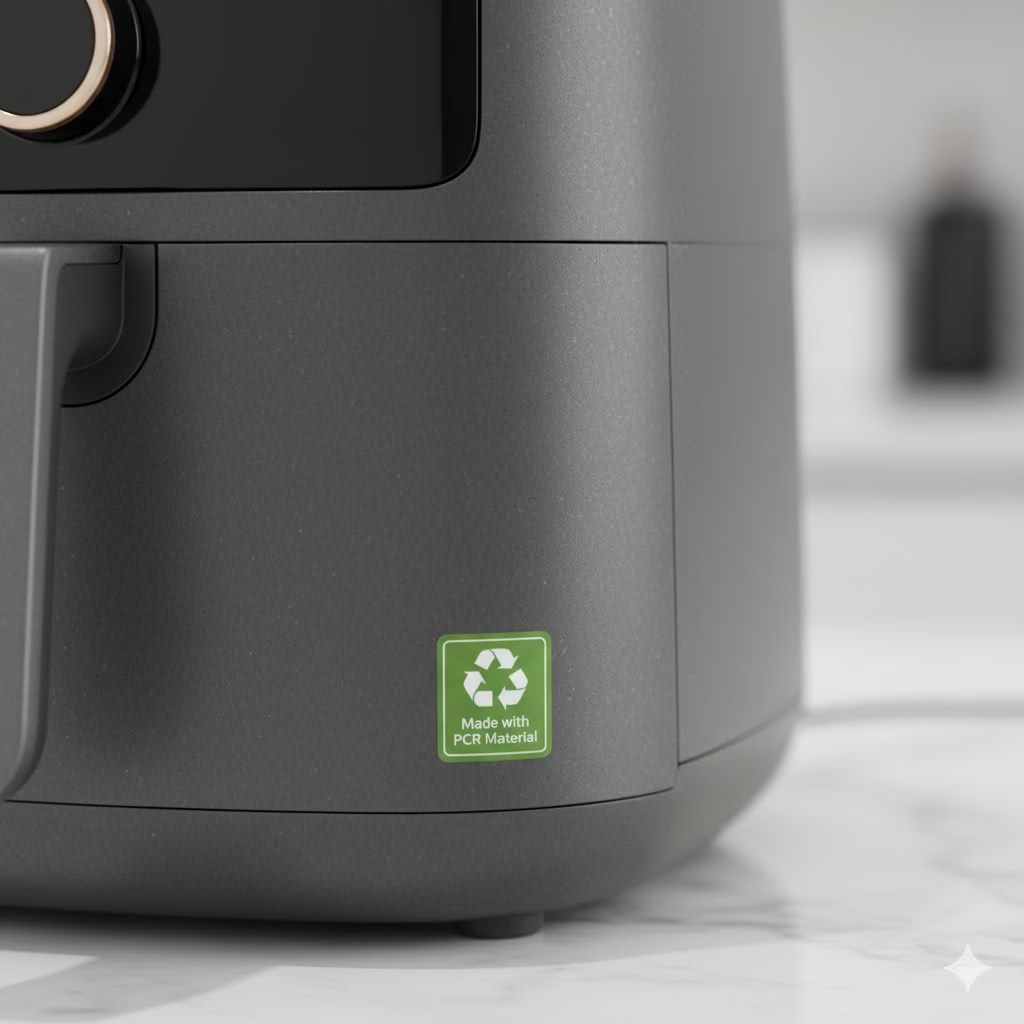
The last, and often most hidden, sustainable secret is using recycled content. This is called Post-Consumer Recycled (PCR) material. It is used to build the appliance. This practice lowers the need for new resources. Creating new materials takes a lot of energy for mining and processing.
Example:
Some air fryer casings and plastic inner parts are now made with PCR plastic. Also, the metals in the heating elements and outer shell may come from certified recycling programs. This information is not always easy to see. But it shows a company’s strong commitment to a circular economy.
How to Do It:
This requires some digging. Look beyond the main product details. Check the company’s official reports on sustainability. Look for their commitment to the environment. Some companies will clearly state that they use PCR content in their products. This makes it simpler for you to choose the greener product.
Conclusion
The modern air fryer is much more than a simple machine for making crispy food. It has features like super-efficient heating and multi-purpose design. And uses durable parts and responsible materials. It is a quiet but powerful tool for living sustainably at home.
Choosing an air fryer that has these 10 Sustainable Secrets is a clear step. It helps you lead a greener life. Every time you skip using a large oven, you save energy. If you choose a machine that lasts, you reduce waste. Every time you clean the non-toxic basket with less water, you help the planet. The secret is now known: your air fryer is a green appliance ready to change the way you think about kitchen sustainability. It makes being eco-conscious easy.
Frequently Asked Questions (FAQ)
Q: Does the air fryer save a lot of energy compared to a regular oven?
A: Yes, the energy savings are big. This is mostly because the air fryer heats up a much smaller space. It needs less energy to preheat. It also cooks food faster. For small to average-sized meals, the energy saved can be huge over a year.
Q: Are air fryers made without PFOA/PTFE just as strong as older ones?
A: Coatings without PFOA/PTFE, like ceramic, can be very strong. But they need careful use. Do not use metal tools on them. The main benefit is stopping the use of harmful chemicals in production and disposal. This makes them a more responsible choice.
Q: How can my air fryer help me waste less food?
A: The air fryer helps cut food waste in two main ways. First, it offers very accurate cooking. This stops you from burning or overcooking food. Second, many models can Dehydrate food. This lets you save fruits, vegetables, and herbs that might otherwise spoil.
Q: If I want an easy-to-fix appliance, what should I look for?
A: Look for brands that have parts that are easy to take out and put back in. Check if the company sells replacement parts for the basket, heating element, or knobs. A long warranty (3 or more years) is a good sign. It means the company trusts the product will last and offers support for repairs.
References
- Technistone – Smart Kitchens: How Modern Technology Is Changing
- Forbes – A Smart Air Fryer Helps This Not-So-Smart Cook
Recent Posts


